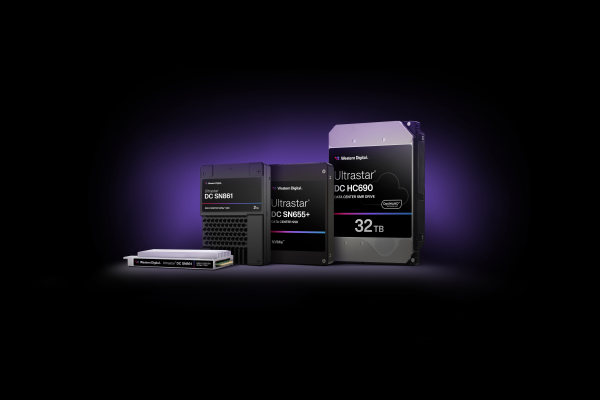![]()
The AI Data Cycle: Understanding the Optimal Storage Mix for AI Workloads at Scale
Special Interview: Rujapa Chutijaturont, Senior Sales Manager, Western Digital (Thailand)

What implications will the proliferation of Artificial Intelligence (AI) have on data storage?
There is no doubt that generative AI is the next transformational technology. As AI technologies become embedded across virtually every industry sector, inspiring a world of new applications, storage is becoming an increasingly important and dynamic component of the AI technology stack. This is because AI models operate in a continuous loop of data consumption and generation. They process existing text, images, audio and video among other data types while simultaneously producing new unique data, much of which will be stored because it’s useful for model context and training. As a result, AI creates a continuous loop of AI data, where increased data generation fuels expanded data storage, which fuels further data generation.
What is the AI Data Cycle and why is it important?
There is a dynamic interplay between AI and data storage that hyperscalers, data centre operators and consumers must understand. As AI grows and evolves, it consumes and creates data across six distinct stages – an AI Data Cycle with specific storage requirements at every stage. Many storage component manufacturers are already updating their product roadmaps to keep up with the accelerating AI-driven requirements to maximise performance and minimise total cost of ownership (TCO).

What are the six stages of the AI Data Cycle?
The first stage is where raw data is collected and securely stored from various sources. The quality and diversity of collected data is key, setting the foundation for everything that follows. This stage requires capacity enterprise hard disk drives (eHDDs) for lowest cost bulk data storage, delivering highest capacity per drive and lowest cost per bit.
In stage two, data is processed, cleaned, and transformed for input to model training. Data centre owners are implementing upgraded storage infrastructure such as fast data lakes to support preparation and ingestion. All-flash storage systems incorporating high-capacity enterprise solid state drives (eSSDs) are deployed to augment existing HDD based repositories, or within new all-flash storage tiers.
During the third stage, AI models are trained iteratively to make accurate predictions based on the training data. Specifically, they are trained on high-performance supercomputers, and efficiency relies heavily on maximising GPU utilisation. As a result, very high-bandwidth flash storage near the training server is important, with high-performance (PCIe® Gen. 5) and low-latency compute optimised eSSDs designed to meet these stringent requirements.

The fourth stage involves creating user-friendly interfaces for AI models, including APIs, dashboards, and tools that combine context specific data with end-user prompts. AI models will be integrated into existing internet and client applications, enhancing them without replacing current systems. This means maintaining current systems alongside new AI compute, driving further storage needs. As a result, current storage systems will be upgraded for additional data centre eHDD and eSSD capacity to accommodate AI-integration into existing processes. Similarly, it will require larger and higher performance client SSDs (cSSDs) for PCs and laptops, and higher capacity embedded flash devices for mobile phones, IoT systems, and automotive to enhance existing applications with AI.
Stage five is where the magic happens in real-time. This stage involves deploying the trained models into production environments where they can analyse new data and provide real-time predictions or generate new content. The efficiency of the inference engine is crucial for timely and accurate AI responses. Organisations might deploy high-capacity eSSDs for streaming context or model data to inference servers, and, depending on scale or response time targets, high-performance compute eSSDs for caching. This will also include high-capacity cSSDs and larger embedded Flash modules in AI-enabled edge devices.
The final stage is where new content is created. The insights produced by the AI models often generate new data, stored because it proves valuable or engaging. While this stage closes the loop, it also feeds back into the data cycle, driving continuous improvement and innovation by increasing the value of data for training or analysis by future models. Generated content will land back in capacity enterprise eHDDs for archival data centre storage, and in high-capacity cSSDs and embedded Flash devices in AI-enabled edge devices.
What will the future look like in terms of increased data generation?
The continuous loop of data generation and consumption is accelerating the need for high-capacity and performance-driven scalable storage technologies for managing large AI data sets and re-factoring complex data efficiently, driving further innovation. The role of storage and access to data will continue significantly influencing the speed, efficiency and accuracy of AI Models, increasing the demand for efficient data storage. As a result, we expect to see storage component providers increasingly tailor products to the needs of each stage in the cycle.
![]()
![]()
บริษัท ซินเน็ค (ประเทศไทย) จำกัด (มหาชน)
33 ถนนสุคนธสวัสดิ์ แขวงลาดพร้าว
เขตลาดพร้าว กรุงเทพฯ 10230
Tel : +66(0) 2553-8888
https://www.synnex.co.th/th/
